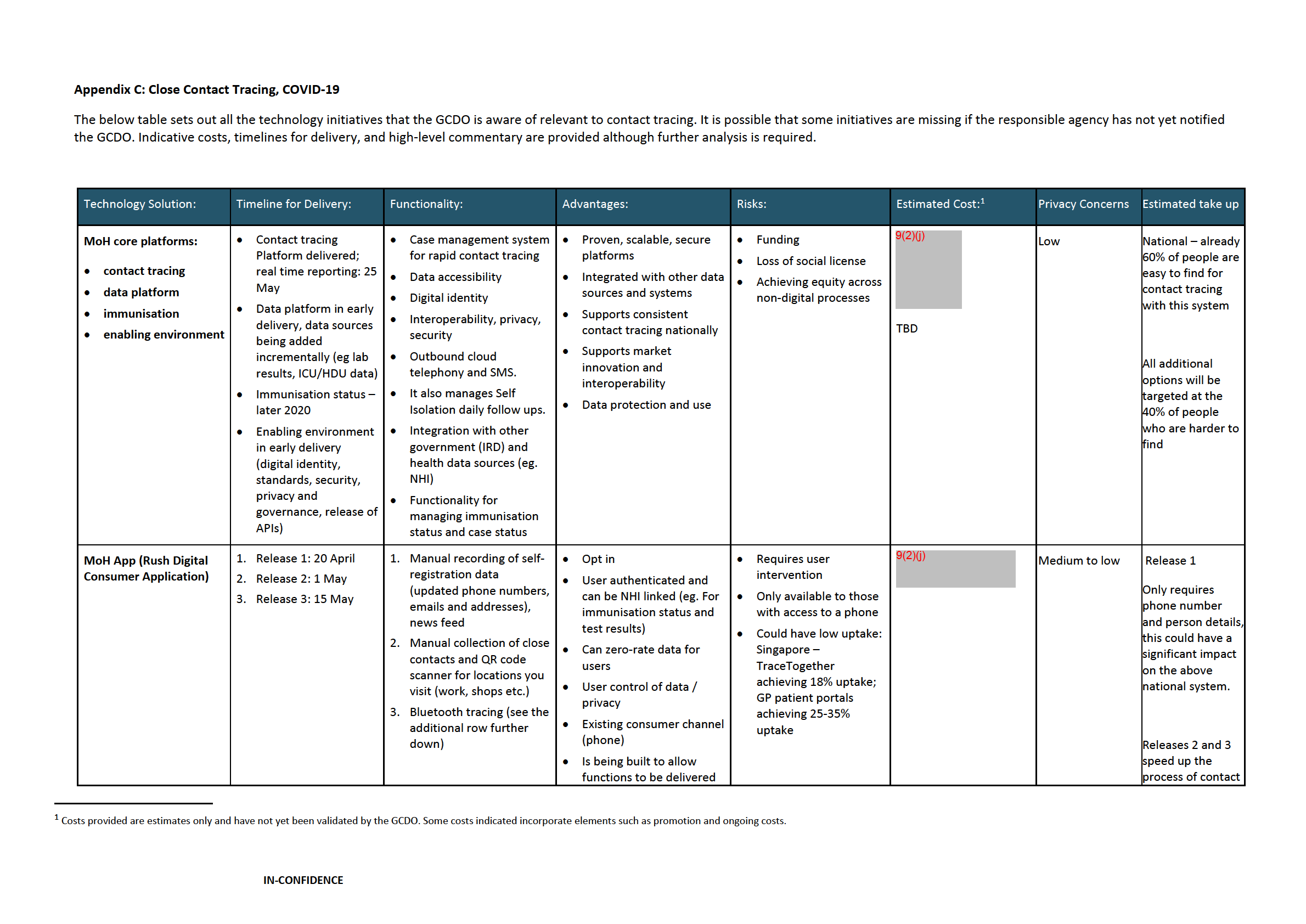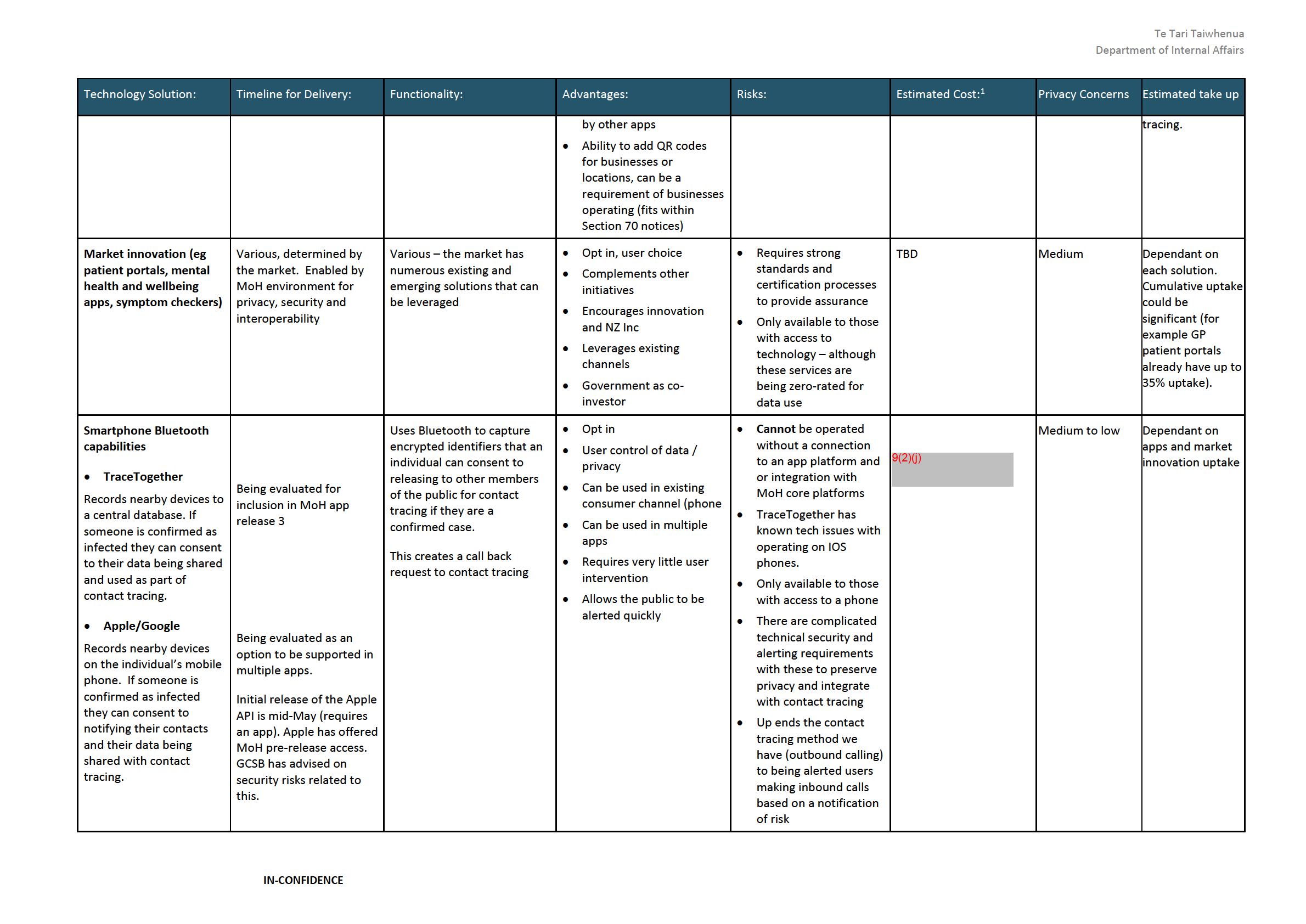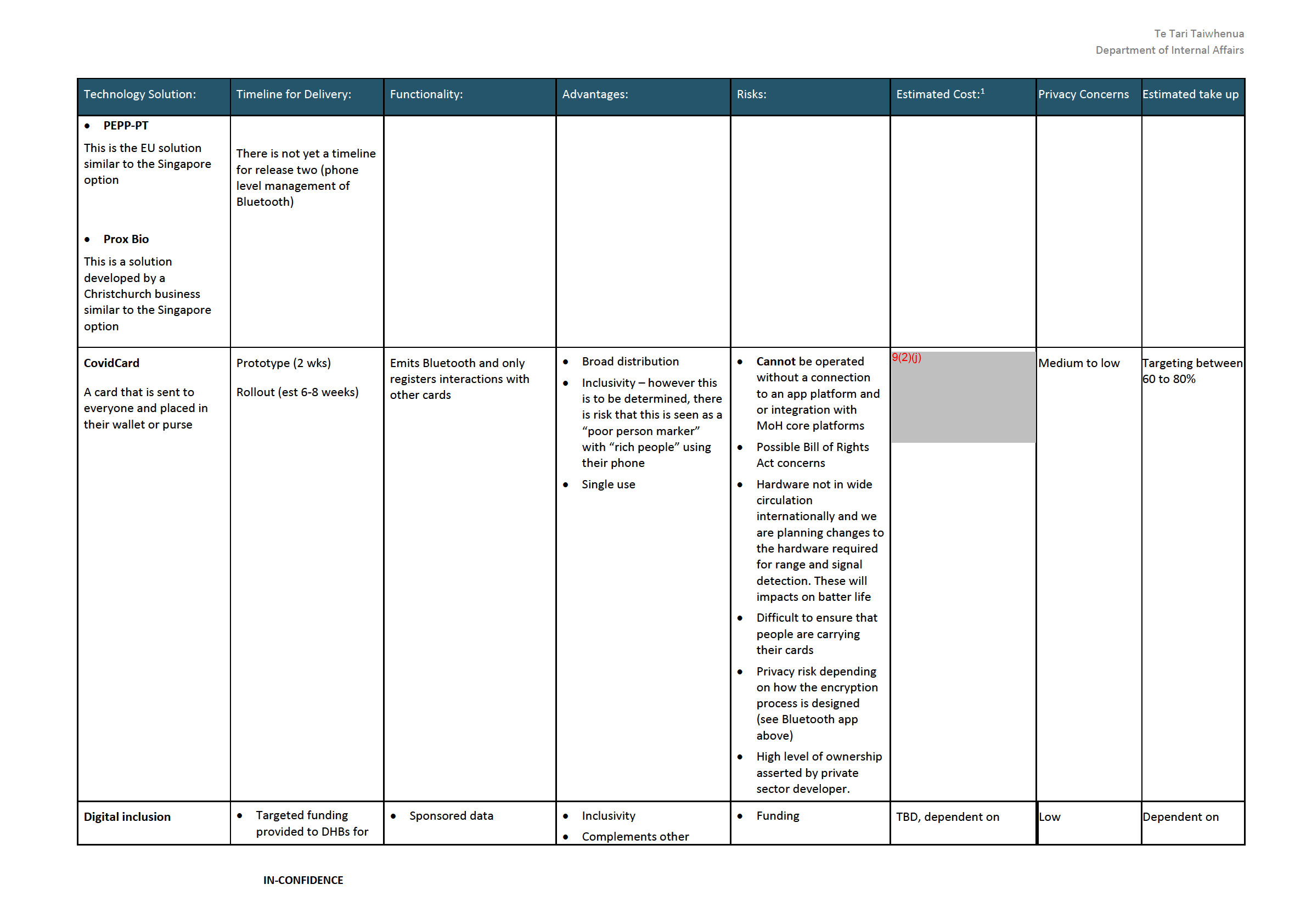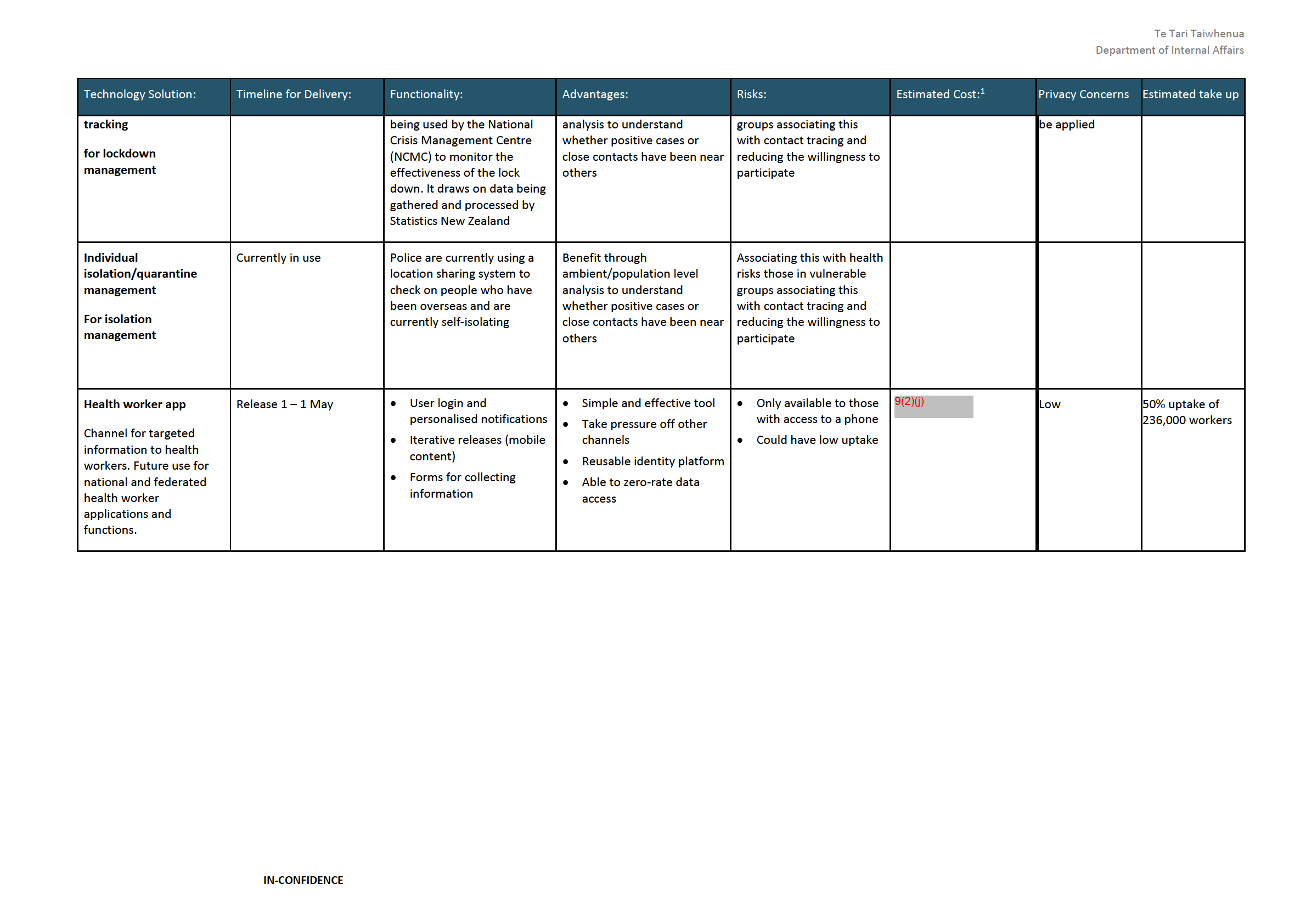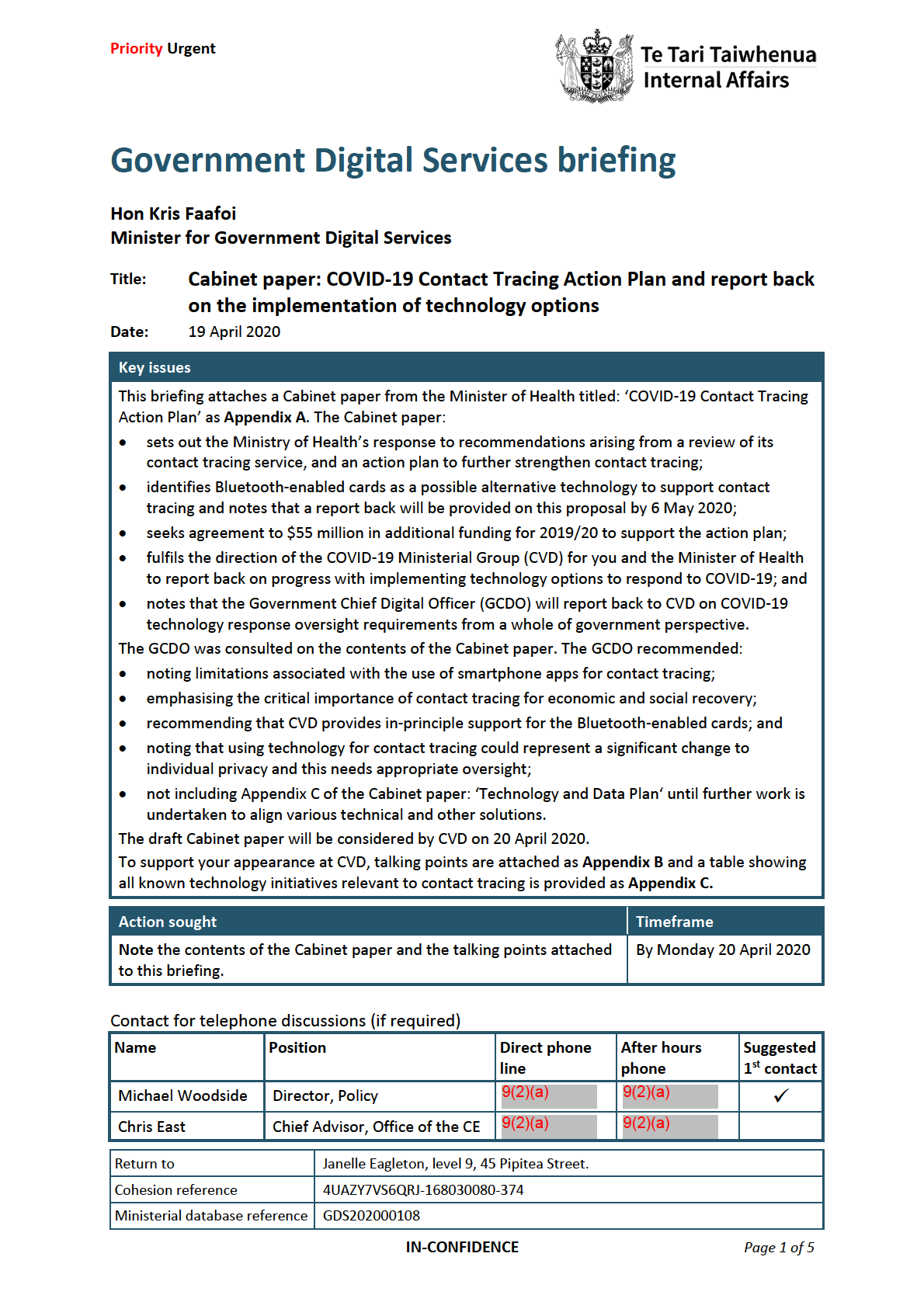
Te Tari Taiwhenua
Department of Internal Affairs
Purpose
1. This briefing attaches a Cabinet paper from the Minister of Health, Hon Dr David Clark,
titled: ‘COVID-19 Contact Tracing Action Plan’ that will be considered by the COVID-19
Ministerial Group (CVD) on Monday 20 April 2020 as
Appendix A.
2. Talking points to support your discussion of this paper are attached as
Appendix B.
Background
3. On 9 April 2020, CVD directed you and the Minister of Health to report back with an
update on progress with implementing technology options to respond to COVID-19
[CAB-20-MIN-0130 refers]. At this meeting, CVD also agreed that priority should be
given to technological enhancements to support contact tracing.
4. You met with the Minister of Health on 16 April and agreed that the report back on
technology options would be provided as part of a Ministry of Health (MoH) Cabinet
paper on contact tracing.
5. MoH commissioned Dr Ayesha Verrall, an infectious diseases specialist at Otago
University, to undertake a rapid audit of the health sector’s approach to contact
tracing for COVID-19 cases.
6. Dr Verrall’s report, attached to the Cabinet paper, recommends that when an
individual receives a positive diagnosis, 80% of their close contacts should be
contacted and placed in self-isolation within 24 hours. Her report also makes a series
of recommendations to support delivery of rapid case detection and contact tracing.
Summary of the Cabinet paper
Update on MoH’s COVID-19 Contact Tracing Action Plan
7. The Cabinet paper’s primary purpose is to set out MoH’s response to the
recommendations made by Dr Verrall in her report. MoH’s responses include:
7.1
developing a COVID-19 outbreak preparedness plan in collaboration with Public
Health Units (PHUs) by 24 April 2020;
7.2
establishing a national contact tracing unit to coordinate and direct local and
national resources to meet contact tracing timeframes;
7.3
establishing a national monitoring framework to provide monitoring and
oversight of contact tracing work carried out by PHUs;
7.4
expanding the new National Contact Tracing Solution (NCTS) to improve
support to PHUs and deliver real-time reporting on system performance;
9(2)(f)(iv)
8. To deliver these enhancements to the contact tracing function, MoH is seeking $55
million in additional funding for 2019/20.
IN-CONFIDENCE
Page 2 of 5
Te Tari Taiwhenua
Department of Internal Affairs
Report back on progress with implementing technology options to respond to COVID-19
9. To support fulfilment of your report back requirement to CVD, the GDCO provided
input on the technology components of the paper.
10. The GCDO recommends that Ministers note that col ecting data proactively could
represent a significant change to individual privacy. Existing contact tracing processes
are retrospective. After a person tests positive for COVID-19, their close contacts are
identified, contacted and directed to self-isolate. Some technology solutions propose
altering this approach by col ecting data on a person’s close contacts before they
receive a positive diagnosis. This accelerates the process of contacting and isolating
these close contacts later on.
11. Privacy implications will mean that people are likely to seek Government assurance on
the security of any technology solution. To build public trust and confidence, and
encourage uptake, proposed solutions wil need to be rigorously tested against the
Government’s agreed principles of public health efficacy; respect for privacy; freedom
of movement; and technical feasibility. The GCDO has a functional leadership mandate
to provide due diligence and assurance for this purpose and to drive a cohesive
approach to digital inclusion across government.
12. The Cabinet paper provides an update on two key technology options: a smartphone
app that is being developed by MoH and a proposal for Bluetooth-enabled cards to
support contact tracing.
Update on MoH smartphone app
13. In addition to the initiatives outlined in their Contact Tracing Action Plan, MoH has
developed a smartphone app that will enable individuals to record their contact
details. These details can then be provided to the contact tracing service if that
individual is identified as a close contact of a confirmed COVID-19 case.
14. MoH’s app is scheduled for release on 20 April 2020. Later versions of the app may
include additional functionality including enabling users to link their profile to their
National Health Index number, manually record their location and close contacts, and
check and report symptoms.
15. There are limitations associated with the use of smartphone apps for contact tracing.
Research from the University of Oxford in the UK, published on 16 April 2020, indicates
that for an app to be effective in suppressing the COVID-19 pandemic in the UK,
extremely high levels of uptake (56% of the total population of the UK), would be
required.
16. Experience in New Zealand and overseas, including Singapore, suggests that a
voluntary smartphone app, on its own, wil not reach enough of the population to
provide effective contact tracing. In Singapore, the TraceTogether app has less than
20% uptake.
Bluetooth-enabled card technology option
17. An alternative technology option being explored includes a proposal for Bluetooth-
enabled cards to be issued to al New Zealanders. The card will record when a
cardholder has come into close contact with another cardholder.
18. Using Bluetooth-enabled cards for contact tracing is likely to have reduced privacy and
security concerns for users when compared to other technologies. This is because the
cards will not record personal or location data and will only store anonymised contact
IN-CONFIDENCE
Page 3 of 5
Te Tari Taiwhenua
Department of Internal Affairs
data until needed. This may make people more willing to use a Bluetooth-enabled
card.
19. The effectiveness of Bluetooth technology for contact tracing in smartphones has been
found to be limited because the range can vary greatly depending on how people hold
their phones, and whether they are indoors or outdoors. Further work is required to
determine if such factors also impact the effectiveness of Bluetooth-enabled cards.
20. MoH, GCDO and the COVID-19 Public Private Partnership team (PPP) are considering
what would be required for successful implementation, how risks would be managed,
privacy and security implications, timing and cost. Initial estimates indicate that
delivery of this option would cost up to $100 million. The PPP is seeking $2 million in
immediate funding to undertake prototyping.
21. The GCDO will provide oversight and assurance, with the lead delivery agency to be
determined. Officials will report back to Ministers on this by 6 May 2020.
Oversight of COVID-19 Technology Solutions
22. The Cabinet paper outlines the need for oversight of technology options being
developed across the public sector to support the COVID-19 response. This will provide
a common operating picture for Ministers and other stakeholders to support long-term
strategic decision-making. Continuing with the current approach of agencies making
independent decisions presents significant risks to effective implementation.
23. The paper recommends that the GCDO reports back to CVD with an analysis of COVID-
19 technology response oversight requirements from a whole of government
perspective, including a COVID-19 technology response plan, and a proposed
governance structure.
24. The GCDO will also continue to deliver provide due diligence and assurance for
enabling COVID-19 technology solutions. This includes assuring Ministers and New
Zealanders that technology solutions wil be effective on public health grounds, while
also on maintaining public trust and confidence by ensuring issues of privacy, security
and digital inclusion are recognised and protected.
Summary of technology initiatives relevant to contact tracing
25. To support your attendance at CVD, on 17 April 2020 your office requested a table
showing al the technology initiatives that the GCDO is aware of relevant to contact
tracing. This table is provided as
Appendix C.
26. The table sets out a broad range of initiatives, some of which have a similar purpose.
This demonstrates the need for oversight across the span of work underway.
27. It is envisaged that the COVID-19 technology response plan referenced in para. 23 will
provide Ministers will a comprehensive picture of all projects proposed and underway.
This will inform decision-making on priorities and investment. It will also support
effective interfacing between technologies (across central government, local
government and the private sector), coherence and inter-operability.
28. The perspective of the private sector is vital in developing a technology response plan.
Businesses are likely to seek to leverage technology to implement their own contact
tracing processes when they resume operations. This may support public uptake, but
guidance will be needed to ensure such systems complement existing government
actions and maintain privacy, security and digital inclusion principles.
IN-CONFIDENCE
Page 4 of 5
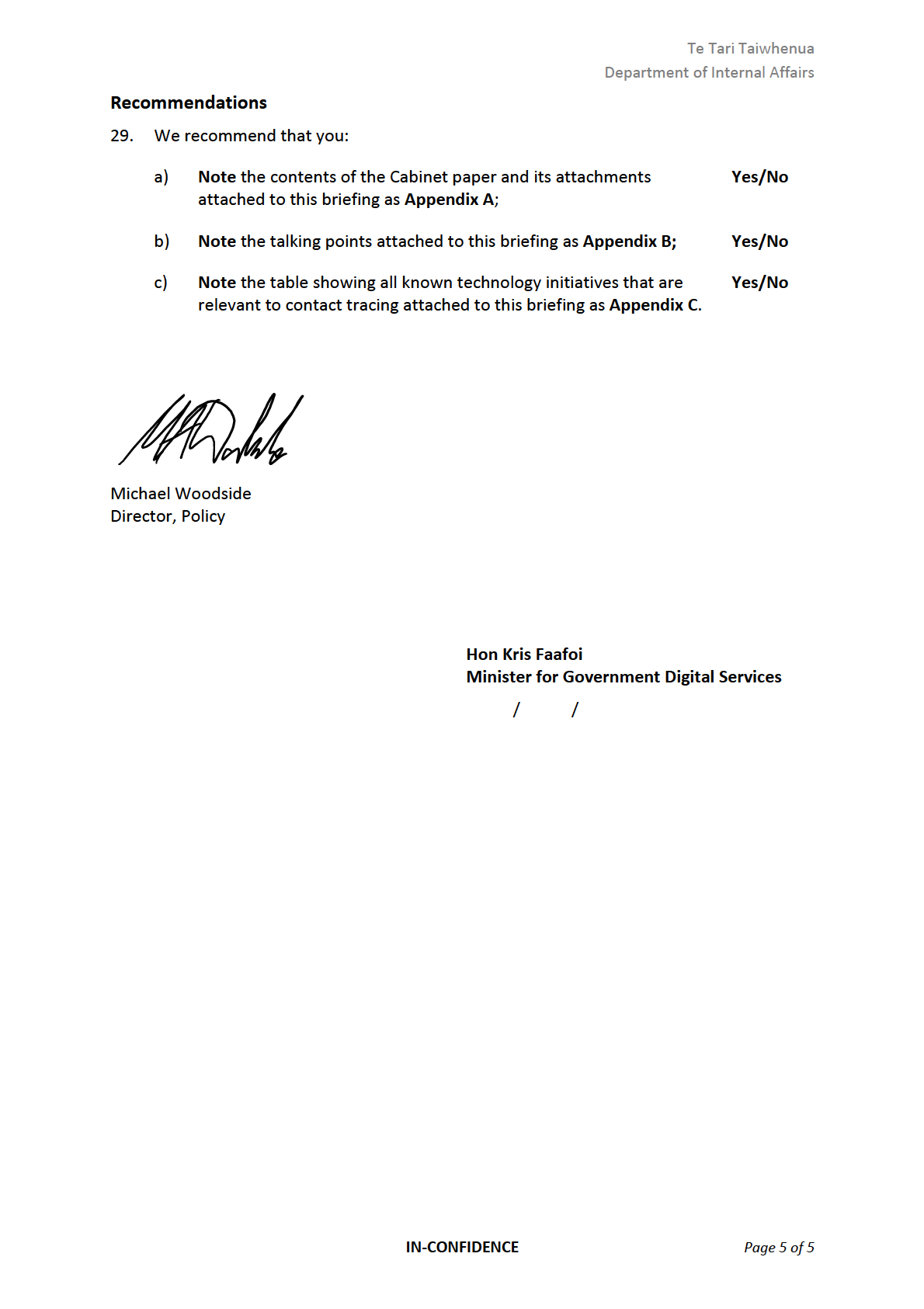
Appendix A: COVID-19 Contact Tracing Action Plan Cabinet paper and attachments
IN-CONFIDENCE
9(2)(g)(i)
